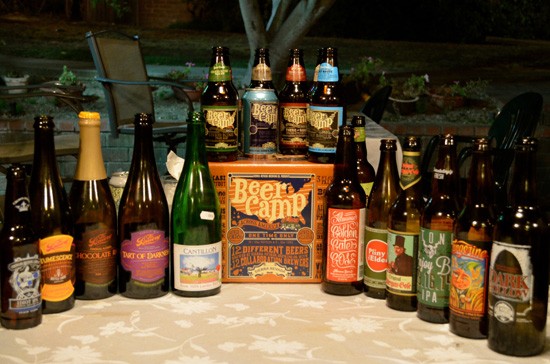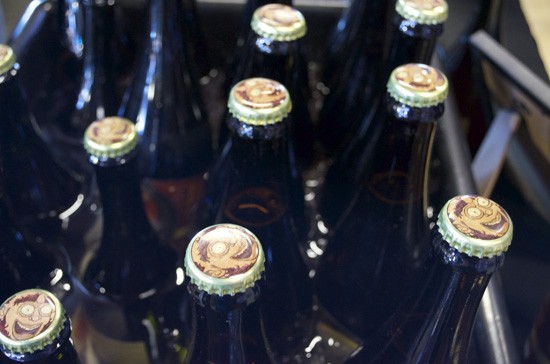
Let's face it, as much as craft beer fanatics enjoy drinking their booze, their passion to collect, store and chronicle every beer they can be even stronger. Words like “limited edition” and “rare” are part of everyday vocabulary for any respectable beer geek and just like any other diehard col-lector, beer enthusiasts like to keep their rare beer–like The Bruery's Black Tuesday–for just the right moment.
However, unlike action figures or trading cards, how and where a beer is stored for that special occasion actually matters [Note: Charles totally has a meticulously double-sleeved Magic: The Gathering deck]. Beer is a living entity, inside a bottle or otherwise, and constantly trans-forms up until the last sip. Because of that, aging and storage conditions play a large role in alter-ing the beverage. Here are five tips to make sure you keep that rare barrel-aged-something-or-other you got for the holidays properly stored for future consumption.
]
5. What to Cellar
Before you go out and buy a second refrigerator to hoard your beer, make sure the beer you're aiming to store is a style you should be storing. Saving a hard-to-find beer for celebration can be tempting, but if that special release beer happens to be a lager, an IPA or a beer where the main flavoring agent is hops, you should refrain from storing. The flavor will dissipate by the time it an occasion worthy enough for drinking the damn thing come around. Stick with aging higher alcohol beers like imperial stouts, sours and barleywines. Although barleywines have their fair share of hops, their flavors develop over time against their maltier foundations.
4. How to Store Your Bottles
When assembling your cellar, be sure to keep your bottles standing upright. Laying bottles on their sides, while good for spacing in your cramped fridge, can damage your beer. The metal caps on beer bottles have a plastic lining to prevent leaking and unwanted metallic flavors. How-ever, this grand design can be brought to its knees if a bottle rests on its side for too long. With the bottle on its side, the beer can erode the plastic and come into contact with those pesky metal caps. Cue metallic off flavors.
And don't think you're clever with storing your cork-finished beer on its side either. When stored on its side, any sediment in the beer, which would typically settle to the bottom, melds with the liquid, making for an undesirable, murky pour. Also, because of the shape of the bottle, when the beer rests on its side it becomes vulnerable to larger pockets of air. This causes oxidiza-tion and will spoil the beer you've waited months (or even years) to finally drink.
[

3. Correct Temperature for Storage
Temperature should be at the top of your list of concerns with cellar conditions. Avoiding any drastic temperature fluctuations or warm areas will ensure your beer ages properly. The best bet is an actual cellaring fridge, but to keep costs low (how else will you afford all those beers?), simply make space in a room that tends to stay roughly around 55 to 65 degrees Fahrenheit. Spo-radic changes in temperature will mess with the beer's structure and, of course, taste. Corners of closets or dry nooks of a basement work nicely but again, be aware of your environment when choosing the optimum cellaring spot.
2. Store Away from Sunlight
Just like excessively warm storage conditions, exposing your beer to sunlight is another thing to avoid like the plague. Sunlight penetrates glass easily and will skunk your beer in no time. There is a reason why you never see stouts or sour beers bottled in clear glass. Although, this doesn't mean a dark bottle is impervious to the sun's skunking abilities, it just takes longer to do so.
1. Duration of Storage
Similar to aging whiskey, aging beers with higher alcohol content for a long period of time will cool off any of that aggressive boozy heat. However, nailing down exactly how long to age any given beer involves much speculation. Because of this wild uncertainty, aging your beer is, ulti-mately, up to your discretion. Rough estimates from Randy Mosher's Tasting Beer pegs any-where from 3 to 20 years for barleywines and imperial stouts, 1 to 4 years for Belgian dubbels and tripels, and 5 to100 years for ultra-strong ales with ABVs ranging from 16 to 26 percent. Typically, a good rule of thumb is if the beer has a higher alcohol content, you're safe to hold off drinking your “special occasion” beer for an actual special occasion.
Follow Stick a Fork In It on Twitter @ocweeklyfood or on Facebook! And don't forget to download our free Best Of App here!


Hmm it seems like your site ate my first comment (it was super long) so I guess I’ll just sum it up what I wrote and say, I’m thoroughly enjoying your blog.
I as well am an aspiring blog writer but I’m still new to the whole
thing. Do you have any tips and hints for first-time blog writers?
I’d really appreciate it.
Hello There. I discovered your weblog using msn. This is a very well written article.
I’ll make sure to bookmark it and return to learn more of your helpful information. Thank you for the post.
I will definitely return.
Thanks , I’ve just been searching for information about this topic for a
long time and yours is the greatest I’ve discovered so far.
However, what in regards to the bottom line?
Are you sure in regards to the supply?
Simply desire to say your article is as amazing.
The clearness to your publish is just great and that i could assume you’re an expert
in this subject. Fine along with your permission allow me
to grasp your RSS feed to keep updated with coming near near post.
Thanks one million and please continue the rewarding work.